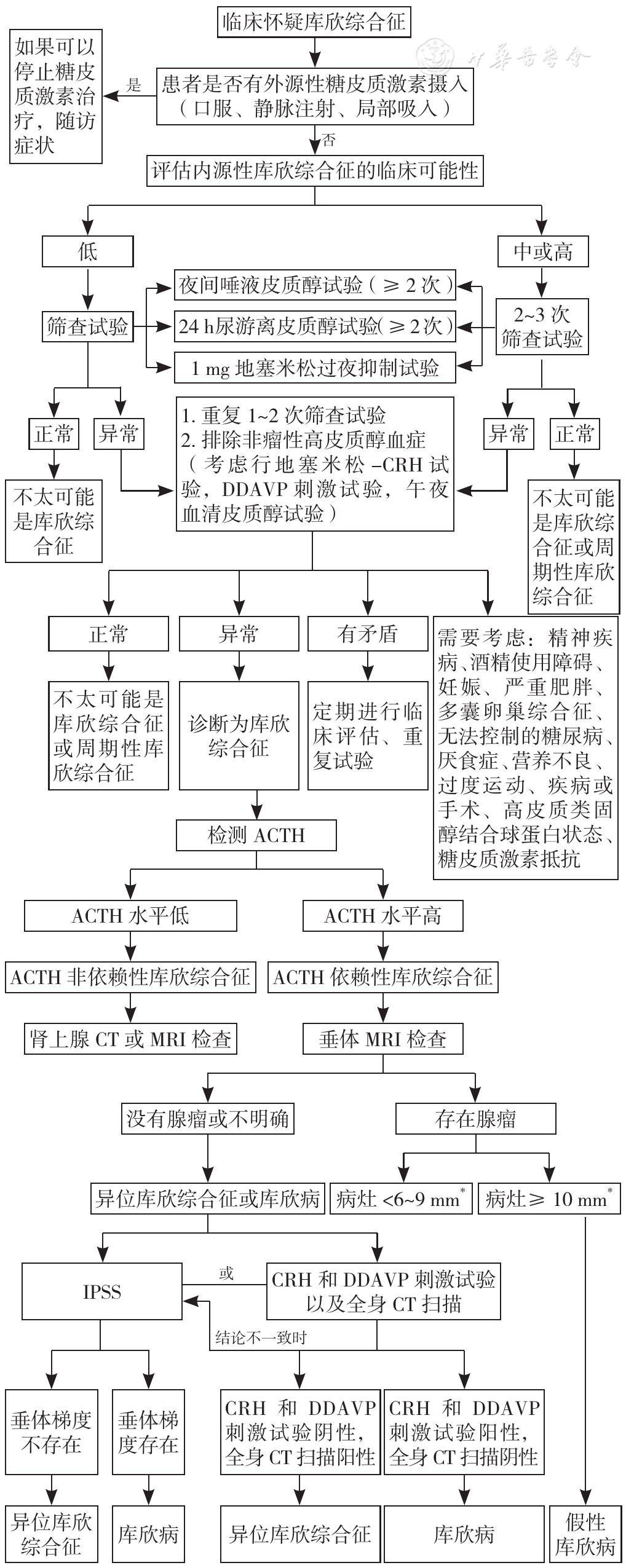中国全科医学 ›› 2022, Vol. 25 ›› Issue (20): 2435-2442.DOI: 10.12114/j.issn.1007-9572.2022.0190
所属专题: 指南/共识最新文章合集
• 指南解读 • 下一篇
谭惠文1,2, 唐宇1, 余叶蓉1,2,*( ), 李建薇1,2, 李佳琦1,2, 安振梅1,2, 王椿1,2, 魏懿2
), 李建薇1,2, 李佳琦1,2, 安振梅1,2, 王椿1,2, 魏懿2
收稿日期:2022-02-15
修回日期:2022-03-20
出版日期:2022-07-15
发布日期:2022-05-19
通讯作者:
余叶蓉
基金资助:
Huiwen TAN1,2, Yu TANG1, Yerong YU1,2,*( ), Jianwei LI1,2, Jiaqi LI1,2, Zhenmei AN1,2, Chun WANG1,2, Yi WEI2
), Jianwei LI1,2, Jiaqi LI1,2, Zhenmei AN1,2, Chun WANG1,2, Yi WEI2
Received:2022-02-15
Revised:2022-03-20
Published:2022-07-15
Online:2022-05-19
Contact:
Yerong YU
About author:摘要: 库欣病是以高皮质醇血症为特征的内源性库欣综合征最常见的病因,是由分泌促肾上腺皮质激素(ACTH)的垂体腺瘤引起的临床综合征。库欣病过度分泌的ACTH刺激双侧肾上腺皮质增生并引起高皮质醇血症,可导致电解质紊乱,糖、脂代谢紊乱等一系列严重的临床症候群,累及全身多个脏器及系统。库欣病临床症状复杂多样,其诊断和治疗极具挑战性。国际垂体协会在2021年12月发布了《库欣病的诊断和管理共识(更新版)》,该指南更新关注库欣病的并发症和合并症,诸如高凝状态、心血管疾病、骨代谢疾病、生长激素缺乏及感染等;讨论了最新证据在临床实践中的应用,尤其侧重于新的治疗选择、筛查、诊断算法以及防治疾病复发的最佳实践。本文立足于最新的循证医学证据,对《库欣病的诊断和管理共识(更新版)》讨论的库欣病相关的实验室检查、影像学检查、诊断和治疗管理流程及复发监测等多方面进行重点解读,以期提高广大全科及专科医师对库欣病的理解,更好地指导规范化的诊疗,改善库欣病患者预后。

图1 库欣综合征诊断流程图注:ACTH=促肾上腺皮质激素,CRH=促肾上腺皮质激素释放激素,DDAVP=去氨加压素,IPSS=岩下窦静脉采血;*共识认为所有病灶直径<6 mm的患者均应行IPSS,病灶≥10 mm的患者不需要IPSS,但专家对于病灶直径为6~9 mm的病灶意见尚未统一
Figure 1 Diagnostic flow chart of Cushing's syndrome
| 检查项目 | 灵敏度(%) | 特异度(%) | 优、缺点 | |
|---|---|---|---|---|
| CS诊断指标 | ||||
| 1 mg-DST | 98 | 81 | 优点:阴性预测值高;易于医疗人员管理 缺点:假阳性率高;地塞米松代谢可影响测定结果;其他药物干扰 | |
| 24 hUFC | 91.0 | 81.5 | 优点:参考范围广 缺点:操作繁琐;样本之间的多变性可能为50%,需要留取2~3个样本 | |
| LNSC | 97.0 | 97.5 | 优点:患者易于操作;应提醒患者在收集唾液样本15 min前不要进食、饮水、吸烟或刷牙 缺点:多变性;根据参考实验室的不同,临界值会有很大的不同;可能被局部氢化可的松污染;并非所有中心均能检测 | |
| CD复发监测 | ||||
| LNSC | 75~90 | 93~95 | 优点:多数患者LNSC的异常早于DST和24 hUFC的异常 缺点:多变性;易出现正常或阴性结果 | |
| 24 hUFC | 68 | 100 | 优点:相对便捷 缺点:大约50%存在变异;容易受体积计量影响而导致异常结果 | |
| DDAVP刺激试验 | 68 | 95 | 优点:可预测存在促肾上腺皮质激素腺瘤;临床腺瘤复发前可以变阳性 缺点:多次采血,动态密集检测 | |
| 1 mg-DST | NA | NA | 优点:可能会在24 hUFC之前出现异常 缺点:评估复发效用方面的证据有限 | |
表1 CS诊断与CD复发监测的实验室检查指标
Table 1 Laboratory tests for Cushing's syndrome diagnosis and monitoring for Cushing's disease recurrence
| 检查项目 | 灵敏度(%) | 特异度(%) | 优、缺点 | |
|---|---|---|---|---|
| CS诊断指标 | ||||
| 1 mg-DST | 98 | 81 | 优点:阴性预测值高;易于医疗人员管理 缺点:假阳性率高;地塞米松代谢可影响测定结果;其他药物干扰 | |
| 24 hUFC | 91.0 | 81.5 | 优点:参考范围广 缺点:操作繁琐;样本之间的多变性可能为50%,需要留取2~3个样本 | |
| LNSC | 97.0 | 97.5 | 优点:患者易于操作;应提醒患者在收集唾液样本15 min前不要进食、饮水、吸烟或刷牙 缺点:多变性;根据参考实验室的不同,临界值会有很大的不同;可能被局部氢化可的松污染;并非所有中心均能检测 | |
| CD复发监测 | ||||
| LNSC | 75~90 | 93~95 | 优点:多数患者LNSC的异常早于DST和24 hUFC的异常 缺点:多变性;易出现正常或阴性结果 | |
| 24 hUFC | 68 | 100 | 优点:相对便捷 缺点:大约50%存在变异;容易受体积计量影响而导致异常结果 | |
| DDAVP刺激试验 | 68 | 95 | 优点:可预测存在促肾上腺皮质激素腺瘤;临床腺瘤复发前可以变阳性 缺点:多次采血,动态密集检测 | |
| 1 mg-DST | NA | NA | 优点:可能会在24 hUFC之前出现异常 缺点:评估复发效用方面的证据有限 | |
| [1] |
|
| [2] |
|
| [3] |
|
| [4] |
|
| [5] |
|
| [6] |
|
| [7] |
|
| [8] |
|
| [9] |
|
| [10] |
|
| [11] |
李佳琦,孙丽思,余叶蓉. 库欣综合征筛查试验的选择和临床应用[J]. 国际内分泌代谢杂志,2021,41(6):573-577. DOI:10.3760/cma.j.cn121383-20210831-08083.
|
| [12] |
|
| [13] |
|
| [14] |
|
| [15] |
|
| [16] | |
| [17] |
|
| [18] |
|
| [19] |
|
| [20] |
|
| [21] |
|
| [22] |
|
| [23] |
|
| [24] |
|
| [25] |
|
| [26] |
|
| [27] |
|
| [28] |
|
| [29] |
|
| [30] |
|
| [31] |
|
| [32] |
茅江峰,柴晓峰,刘丽萍,等. 外周DDAVP兴奋试验在促肾上腺皮质激素依赖性库欣综合征鉴别诊断中的价值[J]. 中国实用内科杂志,2014,34(10):1000-1003.
|
| [33] |
张微微,余叶蓉,谭惠文,等. 精氨酸血管加压素刺激试验与大剂量地塞米松抑制试验在库欣病与异位促肾上腺皮质激素综合征诊断中的价值[J]. 中华医学杂志,2016,96(11):845-849. DOI:10.3760/cma.j.issn.0376-2491.2016.11.004.
|
| [34] |
|
| [35] |
|
| [36] |
|
| [37] |
|
| [38] |
|
| [39] |
|
| [40] |
|
| [41] |
|
| [42] |
|
| [43] |
|
| [44] |
|
| [45] |
|
| [46] |
|
| [47] |
|
| [48] |
|
| [49] |
|
| [50] |
|
| [51] |
|
| [52] |
|
| [53] |
|
| [54] |
|
| [55] |
|
| [56] |
朱蕾蕾,余叶蓉,肖珍,等. 清晨血皮质醇及促肾上腺皮质激素水平用作库欣病经蝶术后缓解标准的临床价值[J]. 四川大学学报:医学版,2019,50(2):260-263. DOI:10.13464/j.scuxbyxb.2019.02.024.
|
| [57] |
|
| [58] |
|
| [59] |
|
| [60] |
|
| [61] |
|
| [62] |
|
| [63] |
|
| [1] | 姚裕忠, 马晓骏, 宋懽, 钟瑜. 基于"全专精准管理"的糖尿病"1358模式"对社区糖尿病患者的管理效果研究[J]. 中国全科医学, 2023, 26(34): 4308-4314. |
| [2] | 李殿江, 潘恩春, 孙中明, 文进博, 王苗苗, 武鸣, 沈冲. 社区2型糖尿病患者临床惰性现状及其影响因素分析[J]. 中国全科医学, 2023, 26(34): 4296-4301. |
| [3] | 林恺, 姚弥, 陈章, 纪欣鑫, 林润琪, 陈永松, Sim MOIRA. 2型糖尿病治疗负担的概念框架及应对方式:基于视频记录分析[J]. 中国全科医学, 2023, 26(34): 4302-4307. |
| [4] | 周俞余, 高川, 崔埔安, 王亚平, 何仲. 更年期综合征患者绝经激素治疗中医患共同决策质量的影响因素研究[J]. 中国全科医学, 2023, 26(33): 4181-4186. |
| [5] | 路广琦, 庄明辉, 朱立国, 高景华, 魏戌, 李路广, 于杰. 腰椎管狭窄症的微创治疗实践指南:2022年美国疼痛与神经科学学会指南解读[J]. 中国全科医学, 2023, 26(32): 3995-4000. |
| [6] | 李茜, 张云淑, 严保平, 王健, 马燕娟, 王媛, 秦英杰, 那龙, 任智勇, 孙俊伟, 邓怀丽, 马宏筠, 曲雪慧, 周楠, 司天梅. 注射用利培酮微球(Ⅱ)治疗急性期精神分裂症患者的疗效及安全性研究[J]. 中国全科医学, 2023, 26(32): 4007-4012. |
| [7] | 朱琳, 郭闫葵, 高琛, 陈学志, 王法帅. 单纯西药、中成药及其联合治疗卒中后失眠疗效的网状Meta分析[J]. 中国全科医学, 2023, 26(30): 3823-3832. |
| [8] | 刘睿方, 徐方兴, 刘同库, 周玉杰, 吴小凡. "Crowbar Effect"技术促进球囊跨过高阻力冠状动脉慢性完全性闭塞病变的有效性和安全性研究[J]. 中国全科医学, 2023, 26(29): 3683-3688. |
| [9] | 王珍, 申国旗, 李亚南, 朱英华, 仇航, 郑迪, 徐通达, 李文华. 急性心肌梗死患者行经皮冠状动脉介入治疗术后发生对比剂急性肾损伤风险预测模型的建立与验证研究[J]. 中国全科医学, 2023, 26(29): 3650-3656. |
| [10] | 蒲瑜, 张吉翔, 董卫国. 铁死亡与炎症性肠病的研究进展[J]. 中国全科医学, 2023, 26(29): 3698-3703. |
| [11] | 任延峰, 刘世蒙, 陶颖, 陈英耀. 抑郁症患者药物治疗偏好的系统综述:基于离散选择实验和优劣尺度法[J]. 中国全科医学, 2023, 26(28): 3559-3564. |
| [12] | 蒋秋惠, 李学军. 运动不是减重之本[J]. 中国全科医学, 2023, 26(28): 3477-3481. |
| [13] | 胡婧伊, 洪景, 郭晓冬, 张晓红, 莫宁, 周小翠, 余钦, 周敏华, 孙艳, 倪柳, 石晓丽, 苏小青, 李玉倩. 社区参与安宁疗护对临终期肿瘤患者干预效果的Meta分析[J]. 中国全科医学, 2023, 26(28): 3573-3584. |
| [14] | 陈静, 邹涛, 赵丹青, 肖子文, 吴献青, 中华医学会心身医学分会围产期精神障碍协作组. 围产期精神障碍筛查与诊治专家共识[J]. 中国全科医学, 2023, 26(28): 3463-3470. |
| [15] | 裴蓓, 成琳, 许凌云. 不同新辅助化疗方案对人表皮生长因子受体2阳性乳腺癌患者免疫指标和肿瘤微环境的影响研究[J]. 中国全科医学, 2023, 26(27): 3435-3440. |
| 阅读次数 | ||||||
|
全文 |
|
|||||
|
摘要 |
|
|||||





